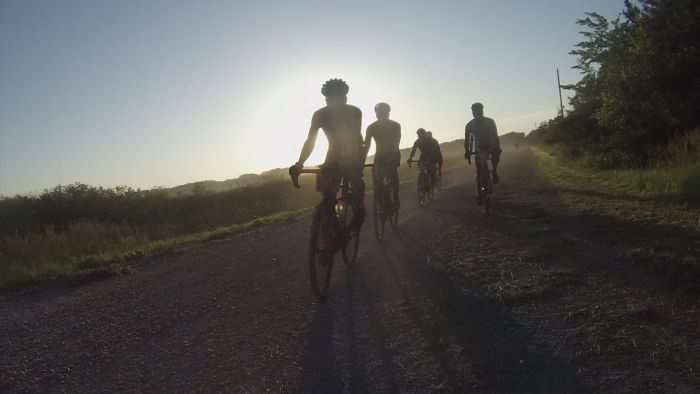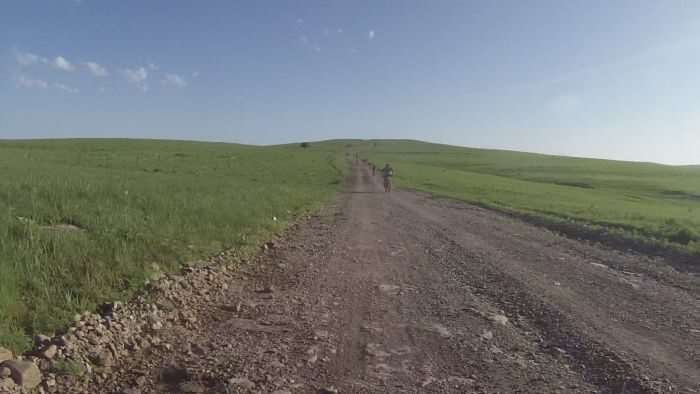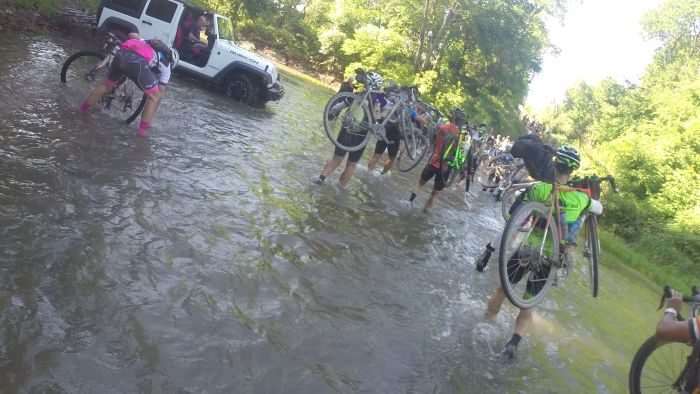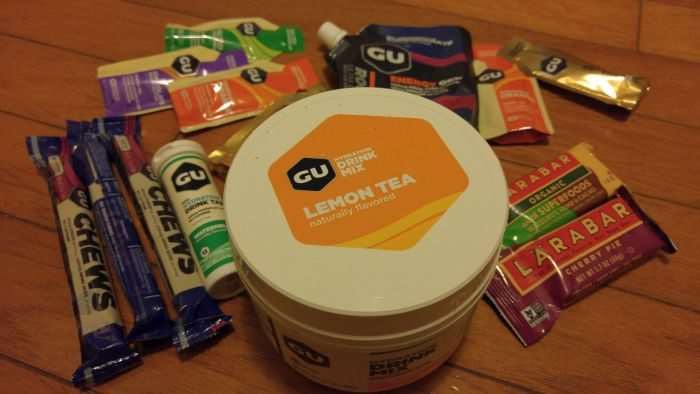Dirty Kanza 200 is not a race to be taken lightly. Two hundred miles of road cycling in one day is difficult enough. For a gravel race such as Dirty Kanza, the rough and unforgiving gravel road surfaces add another element for a rider to deal with. Over 95% of the roads comprising the course are dirt and gravel, and along with contributions by Mother Nature; wind, the possibility of rain, a plethora of tough hills and at least two stream crossings, distance isn’t the only thing to overcome.
Just finishing Dirty Kanza 200 is a major accomplishment.
Fitness and a solid base of endurance training is certainly a must-have for this event, but so is a good dose of experience. That means, good bike handling skills – gravel isn’t always friendly and you can never totally switch off and relax. Self-sufficiency is a necessity – the ability to perform basic mechanical repairs while on the course. You cannot accept support from your crew other than to abandon, or when you pass through the designated checkpoint / re-supply areas. If you cannot handle this concept, gravel racing isn’t for you.
What follows is not intended to be a coaching plan, nor is it an official training plan endorsed by the Dirty Kanza promotional company. I don’t have a coach or power meter, nor do I follow a strict training regime. I am very unscientific in my approach and ride by feel almost all of the time. I think of my training as a loosely formed plan with some flexibility. If I’m feeling a bit dodgy or need additional rest, I’ll disregard the plan and take a day off. Following my plan will not guarantee success. But as a debutante at the 2016 Dirty Kanza who finished reasonably well, I like to think my preparation worked. I hope this year will see me finish the race well and safely!
A proper training plan for the Dirty Kanza 200 should probably begin about three months before the event. This document is coming to you a tad late, but my training for the event officially began a few weeks ago, at the 2017 Dirty Pecan 150. If you haven’t begun training for Dirty Kanza 200, get cracking now!
Still tentative in nature, the table below lists my past and future planned activities leading up to and including 2017 DK200:
Table Key:
| E = Easy | HT = Hard Tempo | I = Intervals | M = Moderate | G = Gravel Riding | P = Pavement Riding | D = Drive Time | F = Fly Time |
For example: P 2HT + I, 1E = Pavement, 2 Hours Hard Tempo with Intervals and 1 Hour Easy
| Monday | Tuesday | Wednesday | Thursday | Friday | Saturday | Sunday | |
| Feb 27 | 1E | G 2HT + I, 1E | Rest or 1E | G 2M | Rest or 1E | Dirty Pecan 150 | P 2E |
| Mar 6 | 1E | G 2HT + I, 1E | D 600 | D 600 + 1E | 2E | Land Run 100 + D 100 | D 1,100 |
| DST Begins | |||||||
| Mar 13 | Rest | P 2HT + I, 1E | Rest | P 1M + 1E | Rest or 1E | G 110 miles tempo | G 93 miles tempo |
| Mar 20 | Rest | P 2HT + I, 1E | Rest | P 1M + 1E | Rest or 1E | P 2E | G Strada Bellamy |
| Mar 27 | Rest or 1E | P 2HT + I, 1E | P 2HT + I, 1E | P 1M + 1E | Rest or 1E | G 125 miles tempo | P 2E |
| Apr 3 | Rest or 1E | P 2HT + I, 1E | Rest | P 1M + 1E | Rest or 1E | G 150 miles tempo | P 1E |
| Apr 10 | Rest or 1E | P 2M, 1E | P 2HT + I, 1E | G 1M + 1E | Rest or 1E | P 125 miles tempo | P 3E |
| Apr 17 | Rest or 1E | P 2M, 1E | P 2M | P 2E | D 400 + 1E | Bootlegger 100 + D400 | Rest |
| Apr 24 | Rest or 1E | P 2HT + I, 1E | P 2M | D 500 + 1E | D 700 + 1E | G 2E | G Paris 2 Ancaster |
| May 1 | D 600 + 1E | D 600 + 1E | P 2HT + I, 1E | P 2E | Rest or 1E | G 175 miles tempo | Rest |
| May 8 | Rest or 1E | P 2HT + I, 1E | P 2HT + I, 1E | P 2M | Rest or 1E | P 2E | P 2E |
| May 15 | Rest or 1E | P 2M | F + Rest | G 2M | G 2E | G Almanzo 100 | F + 2E |
| May 22 | Rest or 1E | P 2 HT + I, 1E | Rest | P 2M | Rest or 1E | G 3M | P 3M |
| May 29 | Rest or 1E | P 2M | Rest + D550 | D550 + 1E | 2E | G Dirty Kanza 200! | D a long way! |
Race Day Nutrition:
The best approach is to experiment in training. Race day is not the day to try a new energy bar or drink mix powder. But remember, sometimes you have to improvise. At last year’s DK200 and the last checkpoint with over 50 miles still to race, my stomach and mind could not tolerate the thought of solid food. I consumed 2 x Mountain Dews and 1 x Coke – horrendous nutrition but the caffeine and sugar got me to the finish. Mind you, things weren’t so pretty about three hours after the finish… err.
For 2017, I will utilize my support crew well (thank you Kuat Racks crew!), leaving a cooler of food and drinks with them.
On the bike / my person, I may* carry:
- 1 x Gu gel flask, loaded with 90% Gu Roctane gel and 10% water. This mix helps liquefy the Gu a little better for easier consumption. Generally each flask contains the equivalent of six to eight gels.
- 4 x Larabars.
- 4 x Gu Energy Chews (the double-serve sleeves).
- 6 x individual Gu Energy Gels, likely non Roctane.
- 2 x Zefal Magnum water bottles with Gu Roctane mix (2 scoops) and 2 x Gu Roctane Electrolyte Capsules (emptied into each bottle).
- 1 x 500ml Platypus foldable water bottle filled with water (stows in a rear jersey pocket).
- 1 x Sticky rice cake infused with Bragg’s Liquid Aminos (great substitute for soy sauce).
- 1 x Hotshot anti-cramp.
- 4 x Gu energy drink tabs – useful for when you’re in a jam.
Generally, I try and consume at least 200 calories per hour and carry more food than I’ll use. Better to have it, than want it!
The cooler with my crew may* contain:
- 6 pre-mixed Zefal Magnum water bottles of hydration mix for the bike – 3 x Gu Roctane and 3 x Gu Hydration Mix, each bottle containing 2 x Gu Roctane Electrolyte Capsules (emptied into bottle).
- Pringles potato chips – salt, fat and carbohydrates.
- Cold Margherita or Veggie pizza – salt, fat and carbohydrates – and a break from all of the sweet stuff!
- 4 x Sticky rice cakes infused with Bragg’s Liquid Aminos (great substitute for soy sauce).
- 1 x Bag of raw cashews.
- 4 x Coca Cola – on a hot day, you cannot put a price on a cold, sugary beverage with caffeine.
- 4 x Pop Tarts – for emergencies.
- 1 x Craft beer – just in case 🙂
- Plenty of individual Gu Gels for reloading.
- A lot of cold water.
Event Day – Don’t forget – Ride your own pace, and not the pace of others.
Bike preparation and spares I carry for the race will follow in Part Two.
Thanks for reading!
* Subject to change.






Nice to see P2A in there although it might be a little short for you! Maybe you could ride it twice 😉 I’ve found the secret on the long events is having a bit of break from the really sweet food. I’ve done a couple of the Toronto-Niagara-Toronto Hairshirt Double Centuries, and I can’t imagine doing it all on gravel roads (although traffic should be better). How do you carry all the food, as well as tools, etc.? All in pockets, or are you using any framebags, top tube bag, etc?
Harris, good point on P2A haha. It is an event I’ve always wanted to attend – tentative at the moment, but let’s hope I make it happen.
Agreed on breaking up the really sweet food – hence my reasoning for pizza in the cooler. I’ve already experimented in training, but the real test will come when I knock out the 175 mile training ride. Last year’s 175 miler was a rough day… I downed a horrendously cheap beer half way through which seemed to do me well 🙂
DK200 generally has the aid stations / check points spaced about 50 miles / 80kms apart. So, what I listed as on the bike is what I generally carry between those points, and load up again at the aid station. Most of that stuff goes into my jersey pockets, but I do jam four loose gels beneath the gripper of each short leg. Last year, I did use a small top tube bag for carrying stuff like the Lara bars. If you’ve noticed, what I’m carrying in terms of sweet stuff is pretty small. The Gu chews are packaged almost in a long tube, so easy to stash multiples of those into your rear pocket. Ditto on Lara Bars.
I’ll post about my tools and bike setup in Part Two, but I use this item – https://www.gravelcyclist.com/bicycle-tech/review-fix-it-sticks-and-bicycle-mounting-bracket/ – and a saddle bag packed to the gills. The Fix It Sticks do a nice job of saving some room, and I keep a small mini-pump attached to the rear bottle cage, just in case of a Co2 fail… but hopefully no punctured tyres!!!
I attended the 2017 training camp in Emporia. It was well worth the money plus your spot in the main event is locked in. During the camp we rode 50 miles on Friday, did a 101 mile half pint on Saturday and another 50 miles on Sunday. I finished the 101 miles on Saturday in under 8 hours and I had to stop twice to pound out cramps. I was not happy. But, I recovered and went on to finish. Friday I rode the 50 in under 3 hours and Sunday I also did the 50 in around 3 hours. I’m still worried about not being fit enough to finish. I want to finish, just finish. I asked the trainers about riding the Almanzo 100 two weeks before DK and they said I shouldn’t do it. They said there isn’t going to be enough rest between and that while Almanzo is a really cool ride doing it will come at the expense of DK. What are your thoughts on all of this? Also, I’m using Trainerroad as my home training program. I used the most hours/hardest effort for both base and build segments and I get really spent by the workouts. My base FTP has gone up over 48 points between Jan. 1 and a week ago. I’m now focusing on riding gravel race events whenever possible. What more should I be doing?
Hi Derek, I’m doing Almanzo 100 this year before DK200, and I’m flying in so there is the hassle and lack of sleep factor that comes with that. I’m not going to worry about what may or may not happen. I generally function on zero rest and not enough sleep, so I may be the wrong person to ask 🙂
You read the training I am undertaking and I am one of the most unscientific riders around. Sure, you need to do some intervals and hard rides here and there, but I keep those reasonably short. On Tuesday nights, I do a roadie group ride with a rotating paceline for about two hours. I also spend an hour riding to and from that ride, nice and easy. Thursdays, I do another roadie ride, but I generally take that one a lot easier. The rest of the time I take it pretty easy, but I do not skimp on the big volume miles. If you’re going to do Dirty Kanza, I say bump up your weekend miles – i.e. pick Saturday as your big mile day, and Sunday to reocover. I’m no coach, but this approach worked well for me – you can see what I have roughly planned on my schedule. The weekend before Almanzo, I am likely to knock out a 175+ mile gravel ride. I’m not letting Almanzo worry me too much about DK.
With all of this said, remember this – I am not a coach, I don’t have a coach nor do I want a coach. Ditto on power meters, don’t use them, I ride by feel. I listed what I’m doing for training but it may not be for everyone. A lot of people get very secretive about their training, but I’m transparent and don’t mind sharing my preparation tips… which I hope prove helpful to some.
So here is my question JOM and I don’t expect an answer right away as I know you rode the DK this weekend. I hope everybody did well. I live here in rural Pa. which really doesn’t have that much gravel riding. The only ride I could think of that I could get in 175 miles in on a day ride would be the C & O canal but that is flatter than a pancake. Would that count or do I have to maybe look at some rides a couple of weeks before the ride/race…..Thanks Larry
Larry, answering your question from a minivan while I take a break from driving…
Where I live in Florida, there isn’t a lot of elevation either. But, I supplemented my training with several other events. Some climbing training certainly helps, but time on the bike is the most important. As an example, a friend of mine who calls Miami home, took 5th in the Men’s 30 – 30 category at the 2016 DK200. He’s a very talented rider, and had no problems with his lack of time in decent hills, etc.
I did the DK50, then the DK100, and now I’m enrolled in the training camp for the DK200. My two kids are both doing the DK high school ride. I really have no idea how I’m going to train enough, help the kids, get us there, support them and try to finish…(Didi, their mother, will also be there for them, thank God).
I noticed the DK website no longer offers an official training guide. I paid $20 for the DK training guide before the DK50 that I’ll use again, as additional info. I’m also doing , HIIT cycle training, core training and also “boot camp” at the YMCA. I just need to be a much fitter person, if I’m to have a chance of finishing the DK200. I don’t know when I should cut back on the cross training and focus on riding. I’ll probably do “core” on the rest days. Just stopping in to thank JOM for sharing his knowledge and experience.
Geoffrey, I wrote out the training plan that I follow for DK200. It isn’t rocket science and I don’t use a coach. With that said, what works for me may not work for everyone, but I feel that you cannot bluff the distance. You have to knock out some serious mileage rides focusing on time in the saddle, figuring out your nutrition, making sure your bike is up to the task, etc. I always train on dirt and gravel roads for DK. Roadie training is well and good, but I like to simulate all of the poundings from the road surface, that is a serious factor of DK.
JOM
I’d love your advice. I’m training for my first Iron Man on April 27. I would like to attempt the DK200 in early June if selected. How much of my IM training will translate? Are these events far enough apart to be feasible? What additional workouts should I add. I am currently riding 5-7 hrs every Saturday until the end of April. Should I increase these long Saturday rides to help with the DK?
Thanks Mac
Hey Mac, firstly, good luck with your Iron Man. That is something I have no desire ever to attempt!
I don’t think you’ll have a problem with the gap between the two events. I ride my last big ride before DK200 – 175 miles – about three weeks before the race. I know the Ironman bike leg is 112 miles and on pavement. You will definitely be challenged to get the miles you need for DK200, but honestly, I think you will be fine, considering you’ll be running a marathon after your 112 mile bike. That should account a lot for your overall fitness. DK200 is a steady effort and at your own pace. Remember, I am no expert, but I’d suggest knocking out at least a 140-mile ride two weeks after your Ironman. If possible, do it on gravel on the bike you plan to ride. That serves as a good test of the bike your body and your nutrition.
Hope this helps!